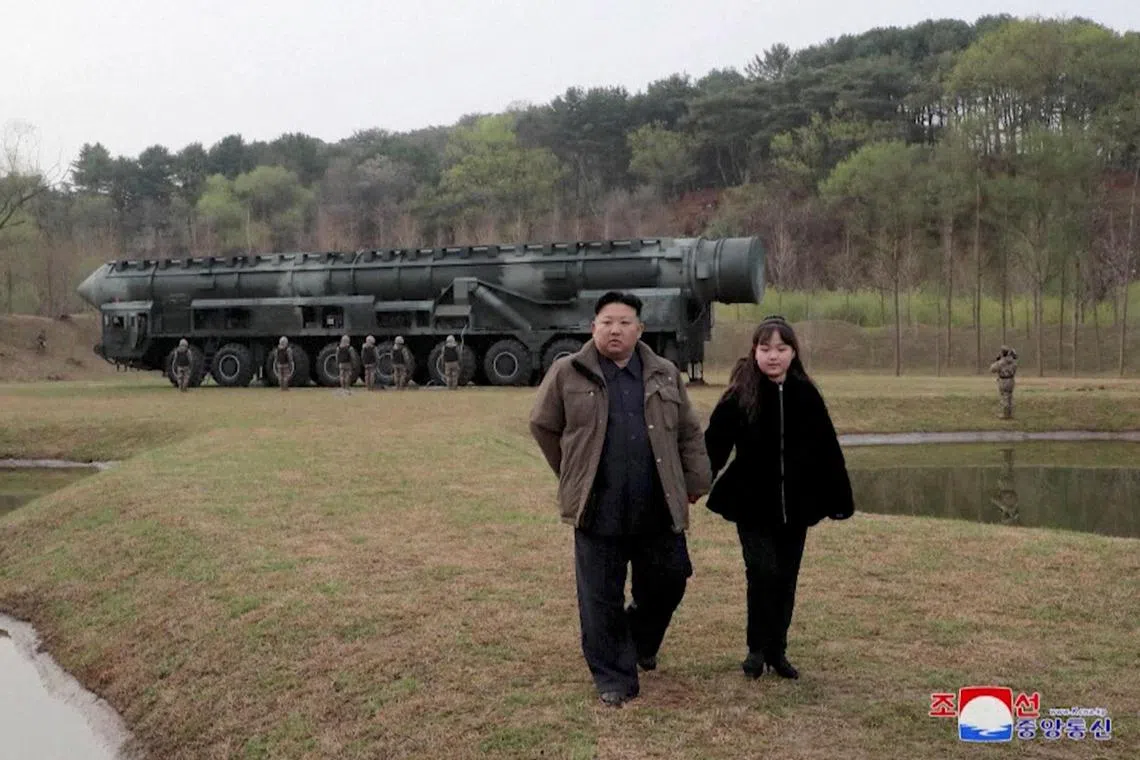North Korean leader Kim Jong Un orders spy satellite launch as planned
Sign up now: Get ST's newsletters delivered to your inbox

North Korean leader Kim Jong Un and his daughter Kim Ju Ae attending a test launch of a new solid-fuel intercontinental ballistic missile Hwasong-18 at an undisclosed location, on April 14.
PHOTO: AFP
Follow topic:
SEOUL – North Korean leader Kim Jong Un has said that preparations for the planned launch of the country’s first spy satellite should go ahead to counter what he called threats from the United States and South Korea, state media reported on Wednesday.
Analysts say the military satellite is part of the reclusive, nuclear-armed state’s efforts to advance surveillance technology, including drones, to improve its ability to strike targets in the event of a conflict.
North Korea in December 2022 conducted what it called an “final phase” test
At that time, it released grainy black and white images of the South Korean capital Seoul, which it said had been taken during the test.
During a visit to the official space agency on Tuesday, Mr Kim told officials to ensure that the launch went ahead on time, and also ordered a series of more reconnaissance satellites to be launched, state news agency KCNA said.
KCNA said that the satellite production has been completed, but it did not elaborate when the scheduled launch date is.
Mr Kim said it was “natural” for the North to develop its military deterrence, criticising deployment of US strategic assets in the region as an attempt “to turn South Korea into an advanced base for aggression and an arsenal for war”.
Japan’s chief Cabinet secretary Hirokazu Matsuno said that even if Pyongyang called it a satellite, any North Korean launch involving a ballistic missile technology would be a clear breach of United Nations Security Council resolutions.
A state media photo showed Mr Kim, accompanied by his daughter, talking to officials in front of a blurred image of an apparent satellite.
North Korea has undertaken an array of missile and weapons tests in recent months, most recently a new solid-fuel intercontinental ballistic missile.
Pyongyang has been threatening “more practical and offensive” action over South Korea-US exercises and refusing to answer inter-Korean hotlines.
In December 2022, five North Korean drones crossed into South Korea and the latter responded by sending surveillance aircraft into the North to photograph its military.
Professor Kim Dong-yup from the University of North Korean Studies said that North Korea wants to use satellites to try and secure real-time information necessary to hit targets when mobilising its missiles and other nuclear delivery systems.
North Korea has had multiple attempts to launch “earth observation” satellites, of which two appeared to have been successfully placed in orbit, including the latest in 2016.
International observers have said that the satellite seemed to be under control, but there was lingering debate over whether it had sent any transmissions. REUTERS

